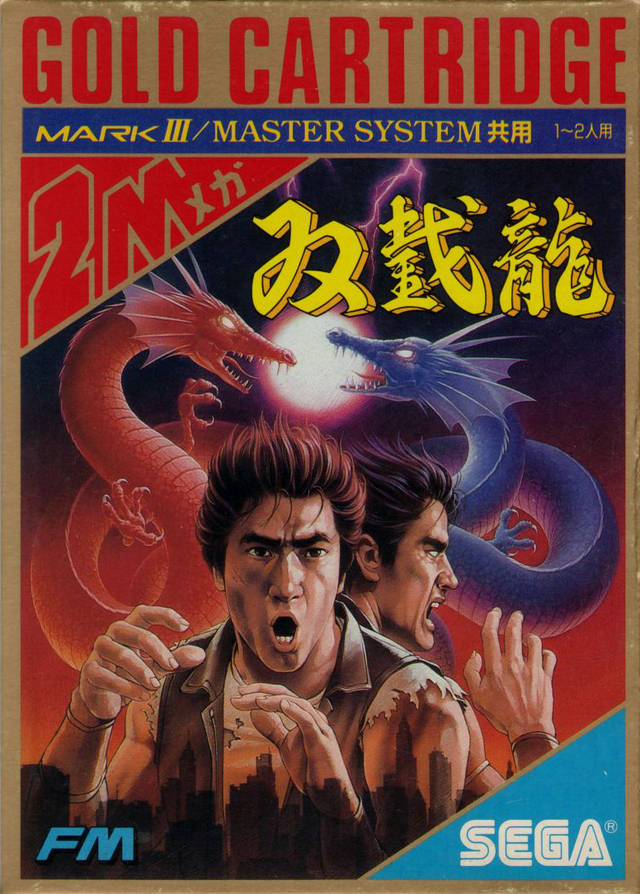
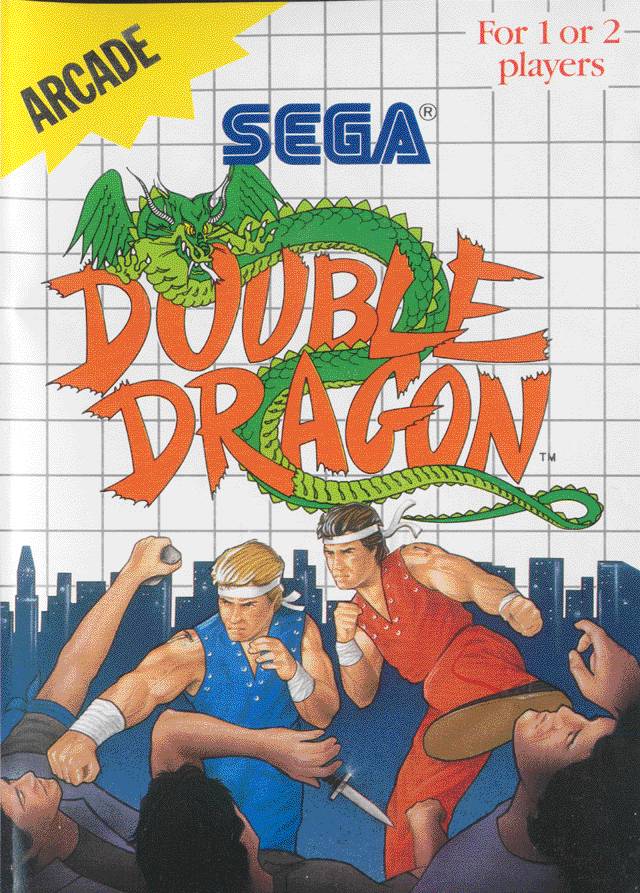
PLAYERS: 1-2 simultaneous
PUBLISHER: Sega
DEVELOPER: Technos (port by Sega)
GENRE: Beat-em-up
RELEASE DATE: 10/01/88 – (JP), 11/88 – (US), 1988 – (EU)
If any brawler can give players lessons in the School of Wayward Fists, it’s Double Dragon. This game was among the first beat-em-ups to equip you with weapons and, more importantly, to provide two player co-op. No thanks to the latter features, Double Dragon was an instant success, paving the way for ports – as many as you could stomach. The flippin’ Atari 2600 got a port of this game! Way to keep the fire burning, Activision.
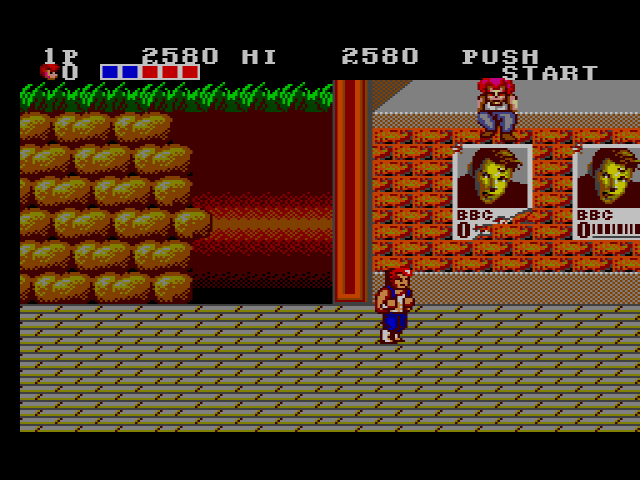
Most gamers either remember the NES port or the Master System port, and for good reason. In 1988, these were the only two consoles that could render proper punch-and-kickery (the near-flawless Genesis version wouldn’t show up until 1992). Neither 8-bit port is arcade perfect, though the Master System comes the closest. The NES version couldn’t handle Billy and Jimmy co-op play (despite the fact that Double Dragon II provided seamless co-op a year later), while the Master System delivered co-op ’til you co-drop. The Master System’s levels are closer in design to the original arcade levels, as well, while the NES version did more or less what it wanted. The NES port did receive a two-player fighting game and a unique upgrade system. With the latter, the more enemies you fought, the more points you received. Said points would then unlock new moves. This is a nice gesture on Technos’s part, but the fighting is primitive and gets old fast. Also, most of the unlockable moves are moves provided from the beginning in the Master System version.
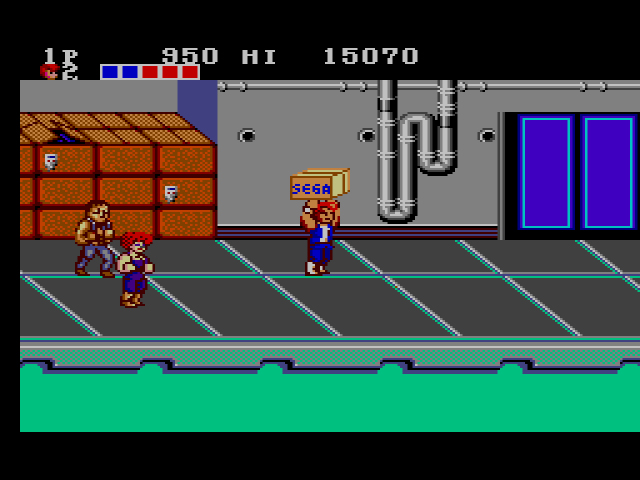
So Double Dragon for the Master System is the default winner, right? Congratulations, Sega, you have the stronger console and thus the better looking, better playing port!… right? Well, hmm. The hit detection for Double Dragon is some of the worst I’ve tussled with in a while. Unless you’re staring your opponent directly in the face, you’ll be roundhouse kicking the air – and leaving yourself open for blows. Hit detection applies to you, but not to the lowlifes you’re up against. Unless you’re positioned apart from them, they can very well hit you wherever they feel like, as long as you’re within kicking distance.
Now, let’s say you and your opponent have locked eyes. You approach them and start being ruthless: headbutts, kidney jabs, the Alabama Shuffle. In the midst of your punches and kicks, your opponent will hit you, sometimes several times, while you are hitting them. What this means is you will always take damage during a fight. Always. The only way to potentially avoid getting hit is to jump kick, run away, jump kick, run away. And even then, sometimes they jump kick into you, sprawling both fighters on the ground. Not only does this suck the fun out of the game, but the NES port does not have this problem. In the NES version, when you got someone in a combo, they took your blows and then tried to sucker punch you.
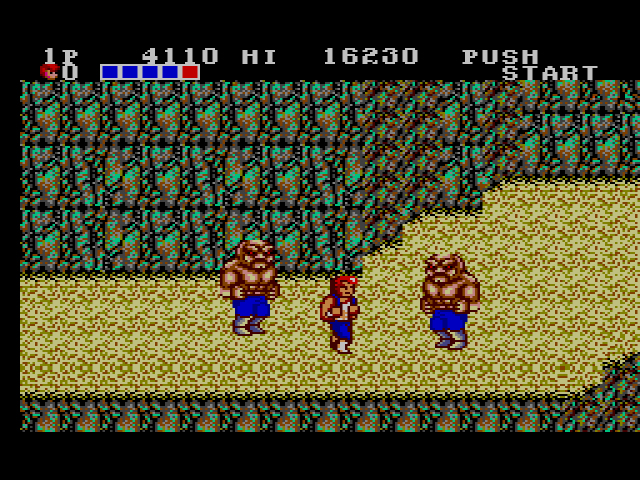
In the NES version, you had three lives to beat all four stages. No continues. Your life bar was ample and would refill at the beginning of a new stage, but otherwise, those three lives were like precious street diamonds. The NES version is tough, sure, but not because the fighting is cheap. Double Dragon for the Master System has unlimited continues until stage 4 – because the game is just that balls hard. Unless your skills are otherworldly or you’re playing with a buddy who’s seen his fair share of the streets, there is no way anyone would make it past stage 1 without these continues. Their inclusion signifies Sega’s laziness. Sega rarely provides continues in their action games (and this port is by Sega, so I feel comfortable calling it a Sega game), let alone a charitable amount like “unlimited.” Sure, they dry up on the last stage, but only because there has to be challenge somewhere.
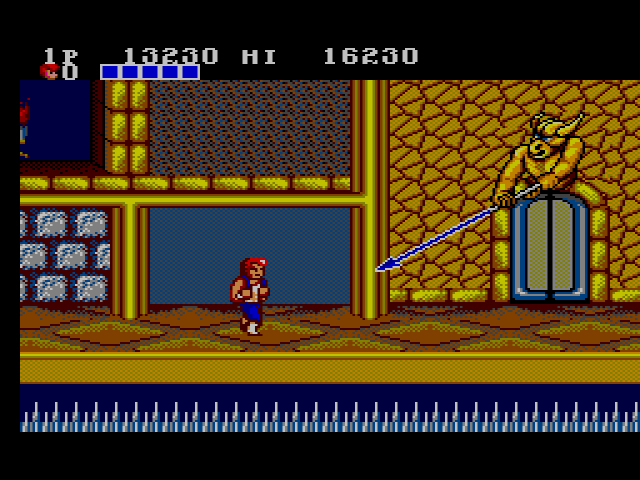
Old habits die hard. In this case, my habit of preferring the NES to the Master System. Double Dragon for the NES may have been the neutered punk between the two ports, but the dearth of co-op didn’t ruin the game. Given the Master System’s roided insides, this version should have been as close to perfection as possible. Alas, no co-op in the world could make Sega’s busted brawling feel right. At least Technos admitted that when they developed Double Dragon for the NES/Famicom, they were unfamiliar with the system’s hardware. What’s Sega’s excuse?
D+

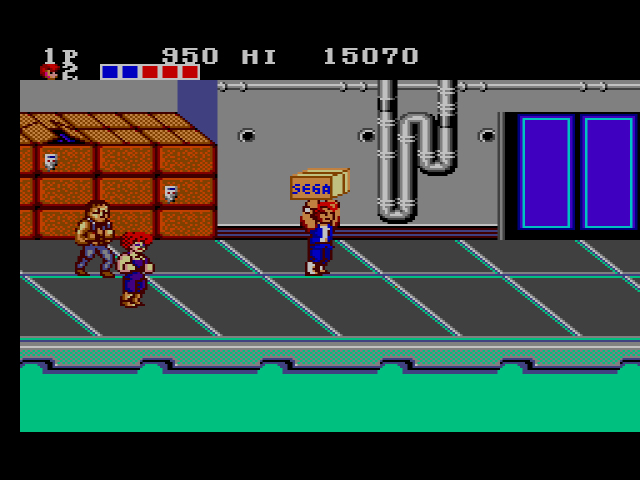
12 replies on “Double Dragon (Master System, 1988)”
I never played this version but I loved the NES one. I’ll never forget the time Dad and I went to rent it and he told the clerk we were looking for the game that let you beat up women. The look on the clerk’s face was priceless! I never could beat the gunman at the end…sad face.
Did any of us beat that gunman?
That was a harsh review of a game that I fondly remember. The sound was great, the graphics were ok, but when playing co-op there seemed to be a little too much on the screen at one time and the flicker was a little bad. I think you’re underestimating how important it was that it was two player though. There just weren’t very many good games of this era that were 2 player. I remember playing this with my friend Todd and an accidental drop kick led to a retaliatory head butt. Before long we had a real life MMA match in my basement. Good times.
I agree that the hit detection was a bit sketchy, but once I got the hang of it I was fine. I do remember that the punch button was far more effective than the kick button. Also the elbow was pretty deadly.
I also have to disagree with you on the difficulty. I don’t think this game needed unlimited continues. I was able to beat it without using any continues and the aforementioned Todd was able to beat it without losing a life.
I would definitely give this game another spin. By a strange coincidence, I played Double Dragon for the NES a few days prior to this review. The differences between the two versions are surprising. I always assumed the NES was the lesser of the two, but I was wrong.
As for the difficulty, let’s agree to disagree. And perhaps ‘difficulty’ is the wrong word. The game’s fighting is cheap. This really became apparent after playing the more balanced NES version.
Different strokes.
I think the frustrating thing with this version of the game is that with a bit TLC this could have been a solid conversion. The NES game, whilst not close enough to the arcade game for my liking is the better version.
It’s a shame Double Dragon never really got the home port it deserved. Even the MegaDrive version despite looking the business doesn’t play right.
I don’t think that the original arcade game had very good controls either. This game is a trailblazer in many respects, but later games like Streets of Rage improved the genre considerably.
I think like Kensieden this is one of those games that has a lot opinions on both sides. I have personally never played this one. I’ve heard some people say how good this version is. And others complain it has issues. Personally I did not like the NES port. I was very upset how unlike the arcade it was, and only single player. But for whatever reason I never bought this version. In retrospect , I think the NES version was on the right track to give a home console experience, even if poorly done. And just because it is arcade like, if it isn’t done well it is not nessesarily better. I’m going to give Dylan the benefit of the doubt since he’s played both. I see a lot of issues with the game.
The more I read about the SMS version of this, the more I like the NES version. Give me crap platforming sections over awful hit detection any day!
I think this is a good version of double dragon for an 8-bit system.
I like the NES version but the leveling up part of the game really bugs me. At least the Master System version gives you the double part of double dragon and that’s what my friends and I loved about this version of the game back in the day, We would beat this game all the time and it was very fun playing a two person version of the arcade game we all loved.
I will admit the NES version holds up better now. But in my opinion the arcade version is so far beyond any home conversion and that also includes the 16-bit consoles.
Great review!
I never really thought there was much argument about which version was superior, with the winner being the SMS. After all its not “Single Dragon.” Although I agree the collision detection is flawed, the fact two players can play together more than makes up for it.
The SMS version also felt more authentic to the arcade with the level designs.
My experience of this one is a bit limited but what I do remember is that the fun of it was watching just how bad me and my mates were at it.
Thanks for the link to the Atari version. I love how the reviewer gave graphics an A.
It took me a while to beat the first level as a kid, but once I reached that milestone it wasn’t long before I could beat it without continuing, whether solo or co-op. I’ll admit it doesn’t hold up all that well now but I still enjoy it.
I played this before ever encountering the NES version. I liked some of the NES level design, but thought the SMS version was more fun. As you and others have said, different strokes.